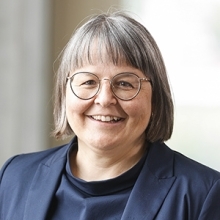By Neil Feinstein, Director, Graduate program in Integrated Advertising Communications, Senior Vincentian Research Fellow, and Associate Professor, The Lesley H. and William L. Collins College of Professional Studies (CCPS)

Neil Feinstein, Associate Professor, CCPS
Nothing is more critical to a successful advertising campaign than understanding the customer. Who are they? What do they care about? Why would they buy your product instead of the competition's?
One proven route to this deep insight is to build a Customer Journey Map, a methodology that is foundational to any integrated advertising program anywhere in the world. Because of its universality, Customer Journey Mapping was an ideal project for St. John’s Global Online Learning Exchange.
Our partner school was Eastern Switzerland University of Applied Sciences (OST). St. John’s Advertising Communications students in ADV 2400 Consumer Research and Creative Strategy partnered with OST Business Administration students in Customer and Channel Management. The four-week program was scaffolded so that students could collaborate through each phase of journey mapping: Consumer Research, Personas, and the end-goal Customer Journey Map. The program concluded with a reflection by each student about their experience.

Preplanning
My OST partner professor, Rosella Toscano-Ruffilli, and I selected an international brand that was consistent with the United Nation’s Sustainable Development Goals: Doctors Without Borders/Médecins Sans Frontières. The overarching campaign objective was to get people 65 and older to become donors.
Fortuitously, there were 15 students in both classes, so we paired them off at the beginning and tasked them with overcoming time and language differences. This was quickly resolved in the ice-breaker activity, as the students posted the menu for their last meal, including a description, translation, and picture, followed by a shared discussion.
Communicating and Collaborating
At first, we selected Microsoft Teams as the communication and content platform, but we encountered technical difficulties. We overcame them by pivoting to Google Docs as the content platform. Students communicated with their partner using WhatsApp.
My OST partner and I communicated frequently in planning and throughout the program. Except for the transition from Microsoft Teams to Google Docs, and a few incidents where students did not respond to their partner (which were easily solved when the professors were notified), this learning experience progressed smoothly—and the collaborations were productive.
Reaching Goals
There were two clear goals: academic proficiency and intercultural competence.
Academically, my partner and I coordinated our in-class lectures so that we taught the Journey Mapping methodologies at the same time. We shared lessons, PowerPoints, and templates so that the students were able to collaborate with the same knowledge base—and the deliverables were consistent on both sides of the Atlantic.
Intercultural competencies developed organically through the one-to-one interactions of the students, mostly on WhatsApp. One anecdote reflects this: As I was walking through the CCPS offices, I saw a student on a sofa having a deep, meaningful, and what appeared to be fun conversation with her partner, based on the smiles and laughs.
My perception that the program was successful was proven as I read the reflections; there was near universal approval of the experience. One of the bonus learning experiences that is particularly relevant in our postpandemic, remote-working world is the skill to collaborate when you are not sitting in the same room as your partners. Advertising is a creative business, and creativity is fueled by collaboration. A project like this arms students with a skill that will be valuable as they move into today’s work world.
Related News
Entangled Across Borders: Celebrating 100 Years of Quantum Physics Through a Global Classroom
In Spring 2025, I implemented the first iteration of the Global Online Learning Exchange (GOLE) in my Scientific Inquiry class at St. John’s University, a core class focused on how scientists make...
Grazie, Papa Francesco: Notes on the Passing of Pope Francis
Loreal is a junior at St. John’s University majoring in International Management with a minor in Social Justice : Theory and Practice in the Vincentian Tradition . She is also the President of the...
Snapshots: New Students from Around the World
The St. John’s community specializes in being a welcoming, friendly, accepting place and so we are excited to introduce you to some of our new international students. We hope these students will...
